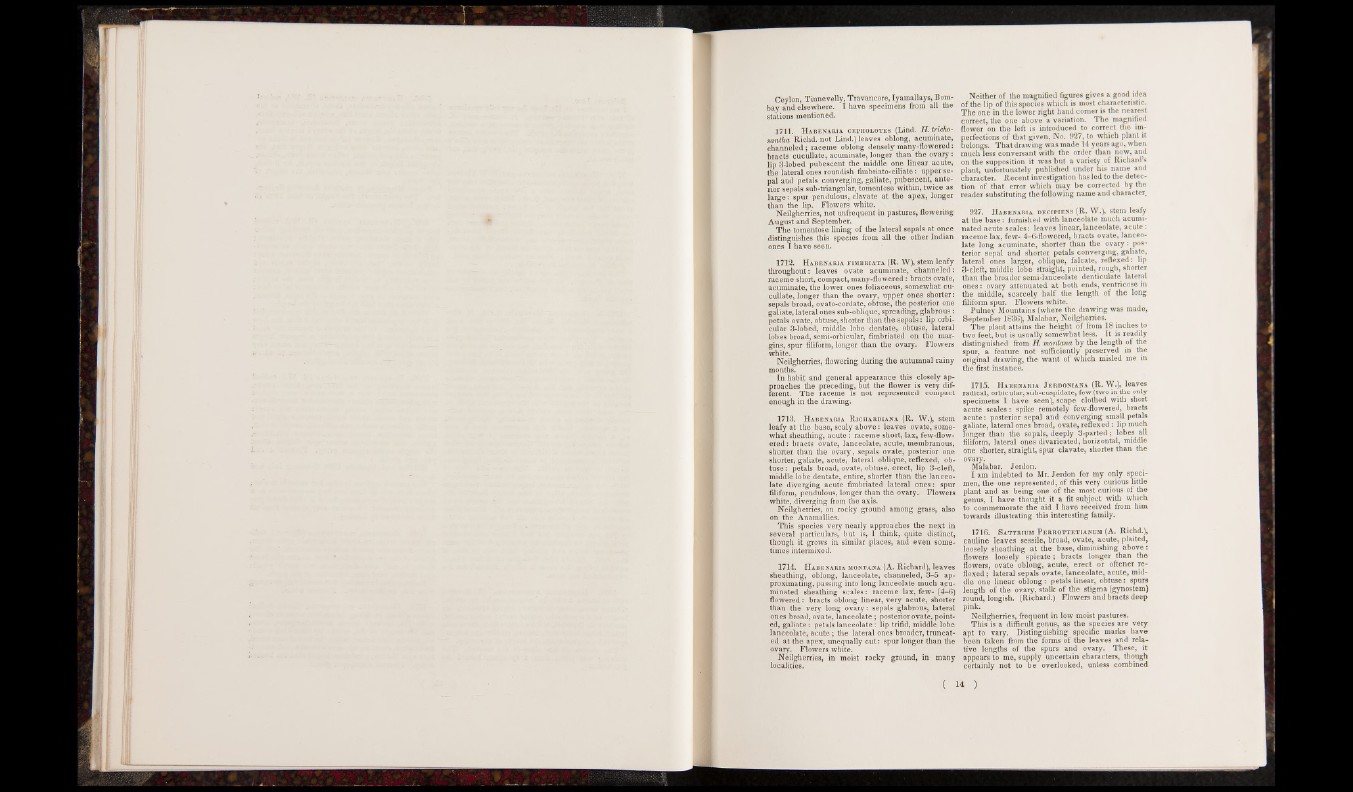
Ceylon, Tinnevelly, Travancore, Iyamallays, Bombay
and elsewhere. I have specimens from all the
stations mentioned.
1711. Habenaria cepholotes (Lind. H. tricho-
santha Richd. not Lind.) leaves oblong, acuminate,
channeled; raceme oblong densely many-flowered:
bracts cucullate, acuminate, longer than the ovary:
lip 3-lobed pubescent the middle one linear acute,
the lateral ones roundish fimbriato-ciliate: upper sepal
and petals converging, galiate, pubescent, anterior
sepals sub-triangular, tomentose within, twice as
larg e: spur pendulous, clavate at the apex, longer
than the lip. Flowers white.
Neilgherries, not unfrequent in pastures, flowering
August and September.
The tomentose lining of the lateral sepals at once
distinguishes this species from all the other Indian
ones I have seen.
1712. Habenaria fimbriata (R. W), stem leafy
throughout: leaves ovate acuminate, channeled:
raceme short, compact, many-flowered: bracts ovate,
acuminate, the lower ones foliaceous, somewhat cucullate,
longer than the ovary, upper ones shorter:
sepals broad, ovato-cordate, obtuse, the posterior one
galiate, lateral ones sub-oblique, spreading, glabrous :
petals ovate, obtuse, shorter than the sepals: lip orbicular
3-lobed, middle lobe dentate, obtuse, lateral
lobes broad, semi-orbicular, fimbriated on the margins,
spur filiform, longer than the ovary. Flowers
white.
Neilgherries, flowering during the autumnal rainy
months.
In habit and general appearance this closely approaches
the preceding, but the flower is very different.
The raceme is not represented compact
enough in the drawing.
1713. Habenaria Richardiana (R. W.), stem
leafy at the base, scaly above: leaves ovate, somewhat
sheathing, acute: raceme short, lax, few-flowered
: bracts ovate, lanceolate, acute, membranous,
shorter than the ovary, sepals ovate, posterior one
shorter, galiate, acute, lateral oblique, reflexed, obtuse
: petals broad, ovate, obtuse, erect, lip 3-cleft,
middle lobe dentate, entire, shorter than the lanceolate
diverging acute fimbriated lateral ones: spur
filiform, pendulous, longer than the ovary. Flowers
white, diverging from the axis.
Neilgherries, on rocky ground among grass, also
on the Anamallies.
This species very nearly approaches the next in
several particulars, but is, I think, quite distinct,
though it grows in similar places, and even sometimes
intermixed.
1714. Habenaria Montana (A. Richard), leaves
sheathing, oblong, lanceolate, channeled, 3-5 approximating,
passing into long lanceolate much acuminated
sheathing scales: raceme lax, few- (4-6)
flowered: bracts oblong linear, very acute, shorter
than the very long ovary: sepals glabrous, lateral
ones broad, ovate, lanceolate; posterior ovate, pointed,
galiate: petals lanceolate: lip trifid, middle lobe
lanceolate, acute ; the lateral ones broader, truncated
at the apex, unequally cut: spur longer than the
ovary. Flowers white.
Neilgherries, in moist rocky ground, in many
localities.
Neither of the magnified figures gives a good idea
of the lip of this species which is most characteristic.
The one in the lower right hand corner is the nearest
correct, the one above a variation. The magnified
flower on the left is introduced to correct the imperfections
of that given, No. 927, to which plant it
belongs. That drawing was made 14 years ago, when
much less conversant with the order than now, and
on the supposition it was but a variety of Richard’s
plant, unfortunately published under his name and
character. Recent investigation has led to the detection
of that error which may be corrected by the
reader substituting the following name and character.
927. Habenaria decifiens (R. W.), stem leafy
at the base: furnished with lanceolate much acuminated
acute scales: leaves linear,lanceolate, acute:
raceme lax, few- 4—6-flowered, bracts ovate, lanceolate
long acuminate, shorter than the ovary: posterior
sepal and shorter petals converging, galiate,
lateral ones larger, oblique, falcate, reflexed: lip
3-cleft, middle lobe straight, pointed, rough, shorter
than the broader semi-lanceolate denticulate lateral
ones: ovary attenuated at both ends, ventricose in
the middle, scarcely half the length of the long
filiform spur. Flowers white.
Pulney Mountains (where the drawing was made,
September 1836), Malabar, Neilgherries.
The plant attains the height of from 18 inches to
two feet, but is usually somewhat less. It is readily
distinguished from H. montana by the length of the
spur, a feature not sufficiently preserved in the
original drawing, the want of which misled me in
the first instance.
1715. Habenaria Jerdoniana (R. W.), leaves
radical, orbicular, sub-cuspidate, few (two in the only
specimens I have seen), scape clothed with short
acute scales: spike remotely few-flowered, bracts
acute: posterior sepal and converging small petals
galiate, lateral ones broad, ovate, reflexed : lip much
longer than the sepals, deeply 3-parted; lobes all
filiform, lateral ones divaricated, horizontal, middle
one shorter, straight, spur clavate, shorter than the
ovary.
Malabar. Jerdon.
I am indebted to Mr. Jerdon for my only specimen,
the one represented, of this very curious little
plant and as being one of the most curious of the
genus, I have thought it a fit subject with which
to commemorate the aid I have received from him
towards illustrating this interesting family.
1716. Satyrium Perrottetianum (A. Richd.),
cauline? leaves sessile, broad, ovate, acute, plaited,
loosely sheathing at the base, diminishing above:
flowers loosely spicate; bracts longer than the
flowers, ovate oblong, acute, erect or oftener reflexed
; lateral sepals ovate, lanceolate, acute, middle
one linear oblong: petals linear, obtuse: spurs
length of the ovary, stalk of the stigma (gynostem)
round, longish. (Richard.) Flowers and bracts deep
pink.
Neilgherries, frequent in low moist pastures.
This is a difficult genus, as the species are very
apt to vary. Distinguishing specific marks have
been taken from the forms of the leaves and relative
lengths of the spurs and ovary. These, it
appears to me, supply uncertain characters, though
certainly not to be overlooked, unless combined